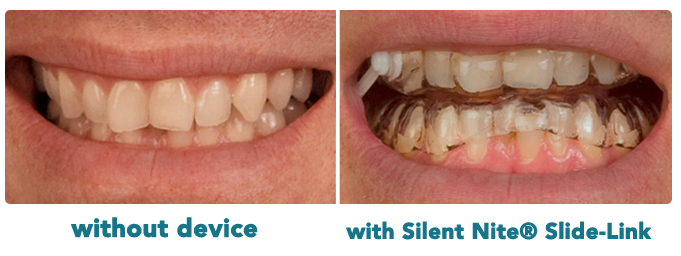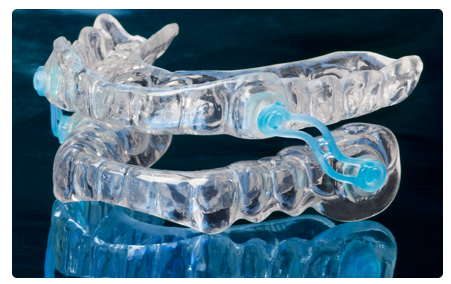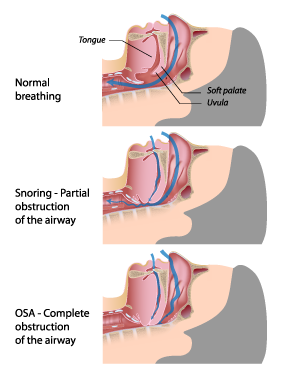Sleep Apnea / Snoring
Obstructive sleep apnea (OSA) is a condition in which the flow of air pauses or decreases during breathing while you are asleep because the airway has become narrowed, blocked, or floppy. All of the muscles in your body become more relaxed during sleep. This includes the muscles that help keep the airway open and allow air to flow into the lungs.
Normally, the upper throat still remains open enough during sleep to let air pass by. However, some people have a narrower throat area. When the muscles in their upper throat relax during sleep, their breathing can stop for a period of time (often more than 10 seconds). This is called apnea.
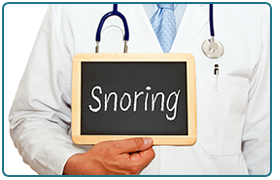 The snoring in people with obstructive sleep apnea is caused by the air trying to squeeze through the narrowed or blocked airway. Some patients have obstructions that are less severe called Upper Airway Resistance Syndrome (UARS). In either case, the individuals suffer many of the same symptoms.
The snoring in people with obstructive sleep apnea is caused by the air trying to squeeze through the narrowed or blocked airway. Some patients have obstructions that are less severe called Upper Airway Resistance Syndrome (UARS). In either case, the individuals suffer many of the same symptoms.
A person who has obstructive sleep apnea often is not aware of the apnea episodes during the night. Often, family members witness the periods of apnea.
A person with obstructive sleep apnea usually begins snoring heavily soon after falling asleep. Often the snoring gets louder. The snoring is then interrupted by a long silent period during which there is no breathing. This is followed by a loud snort and gasp, as the person attempts to breathe. This pattern repeats. People with obstructive sleep apnea may not be aware that their sleep was interrupted. In fact, many people with this type of sleep apnea think they slept well all night.
Many people wake up unrefreshed in the morning and feel sleepy or drowsy throughout the day. This is called excessive daytime sleepiness (EDS).
At our office, we will perform a complete history and physical exam. This will involve carefully checking your mouth, neck, and throat. You will also be asked a series of questions about daytime sleepiness, sleep quality, and bedtime habits. In addition, for those patients who show possible signs of Obstructive Sleep Apnea, we will do a preliminary volumetric airway analysis with the use of our 3D Cone Beam CT Scanner in order to determine the location of the airway obstruction.
A sleep study (polysomnogram) is used to confirm obstructive sleep apnea. The goal of OSA treatment is to keep the airway open so that breathing does not stop during sleep.
In recent years, the prevalence of treating patients suffering from Obstructive Sleep Apnea with Oral Appliance Therapy (OAT) has increased. We have a nonsurgical approach to Sleep Apnea or Upper Airway Resistance that may be used on its own or in conjunction with other treatment. Through the use of Oral Appliance Therapy, patients have reported better sleep, more energy, overall better health, as well as decrease in bed partner’s report of snoring since undergoing treatment.
OSA is a very serious condition that needs careful attention and treatment. Untreated obstructive sleep apnea may lead to or worsen heart disease, including heart arrhythmias, heart failure, high blood pressure, or stroke. Please give our office a call today so that you can experience a better night’s sleep as well as an overall improvement in health through the use of Oral Appliance Therapy.
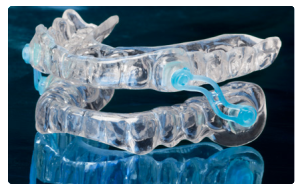 Silent Nite® Slide-Link
Silent Nite® Slide-Link
AVAILABLE at Pasadena Family, Cosmetic & Implant Dentistry
Snoring can be a real problem, not only for the person who snores, but for the partner and other family members who live with the snorer. However, there is a dentist-prescribed solution for a more restful night’s sleep: Silent Nite® SL. This affordable device is flexible, thin and comfortable for your patients, and it exhibits documented clinical success in mitigating or even preventing the disruptive, unhealthy effects of snoring and sleep apnea.
Silent Nite® sl positions the lower jaw forward using special S-shaped connectors that are attached to upper and lower trays. These trays are comprised of a soft inner layer with a hard outer layer that is durable and BPA-free.
